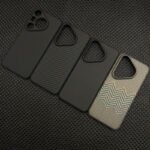What are the property differences between Kevlar and carbon fiber?
While both Kevlar and carbon fiber are high-strength, lightweight materials, they have distinct differences that make them suitable for different applications.

Here are the key property differences between Kevlar and carbon fiber
| Features | Carbon Fiber | Kevlar (Aramid Fiber) | Remark |
| Material Composition | Carbon elements | Poly-para-phenylene terephthalamide (Aramid) | Kevlar’s unique chemical structure leads to its distinctive performance. |
| Signal Impact | Can block phone signals (Wi-Fi, GPS, cellular), especially with wrap-around designs. | No signal interference; zero impact on phone signals, ensuring smooth communication. | Have your customers complained about signal issues? Kevlar solves that perfectly. |
| Thinness & Lightness | Extremely light and thin. | Also extremely light and thin, it can be even thinner (e.g., 600D aramid) with a more delicate feel. | When it comes to ultimate thinness and lightness, Kevlar can perform even better and offers a more comfortable feel. |
| Durability & Toughness | High hardness and strength, but relatively brittle; prone to cracking upon impact (e.g., crack propagation). | Extremely high toughness and tear resistance; impact-resistant and wear-resistant; not easily shattered or deformed. | Key Advantage! Kevlar’s toughness far exceeds carbon fiber’s, allowing it to absorb impact better and be more durable. |
| Appearance & Feel | Classic glossy or matte carbon fiber texture, with a hard tactile feel. | Typically a matte or slightly velvety texture with a unique weave pattern; a more delicate, skin-friendly, and anti-slip feel. | Kevlar isn’t just unique; its warmer feel enhances the user experience. |
| Cost | High cost. | Typically even higher than carbon fiber (especially for high-quality aramid fibers). | Guide strategically to align its value with the higher cost. |
| Color Options | Primarily black; occasionally available with colored weaves. | It can be dyed to achieve more color options, or naturally presents a more unique dark tone. | Kevlar offers more space for high-end customization in terms of colors and textures. |
While both Kevlar and carbon fiber are highly sought after in the premium phone case market, they have significant differences in their application, market acceptance, and customer preferences.
Differences in Application
- Carbon Fiber: Known for its high hardness and rigidity, carbon fiber is excellent for providing structural protection. However, its electrical conductivity is a major drawback. Carbon fiber can block or weaken a phone’s wireless signals like Wi-Fi, cellular, and GPS, especially with wrap-around designs. This creates a functional limitation.
- Kevlar (Aramid Fiber): Kevlar stands out for its superior toughness and impact resistance. It effectively absorbs and disperses impact force, making it exceptional for drop protection. Most critically, Kevlar is not conductive, so it has zero impact on a phone’s signals. This makes it an ideal material for premium phone cases, as it balances strong protection with uninterrupted communication.
Market Acceptance and Customer Preference
- Carbon Fiber:
- Market Positioning: Carbon fiber phone cases typically target customers who desire an ultra-thin, rigid look, and motorsports aesthetics. Its classic black woven texture conveys a high-tech, luxurious feel.
- Acceptance: Market acceptance for carbon fiber is high, but the customers are a specific niche who are willing to pay for aesthetics and a thin feel, and can accept the potential signal issues. Some consumers may not even be aware that carbon fiber can affect their signal until they start using the case.
- Kevlar:
- Market Positioning: Kevlar phone cases target consumers who prioritize zero signal interference and superior protection. They also emphasize thinness, but with a focus on Kevlar’s unique toughness and a warmer, softer touch.
- Acceptance: Kevlar’s market acceptance is steadily growing, particularly among customers who value functionality over pure looks. As consumers become more knowledgeable about the properties of case materials, more people are realizing that Kevlar offers better overall protection without sacrificing signal integrity. Its unique texture and customizable color options also appeal to customers who want a personalized and comfortable feel.
Summary
- Choose carbon fiber if you prefer a rigid, high-tech aesthetic and don’t mind potentially sacrificing some signal strength.
- Choose Kevlar if you prioritize an ultra-thin experience with no signal interference, along with superior drop and impact protection.
